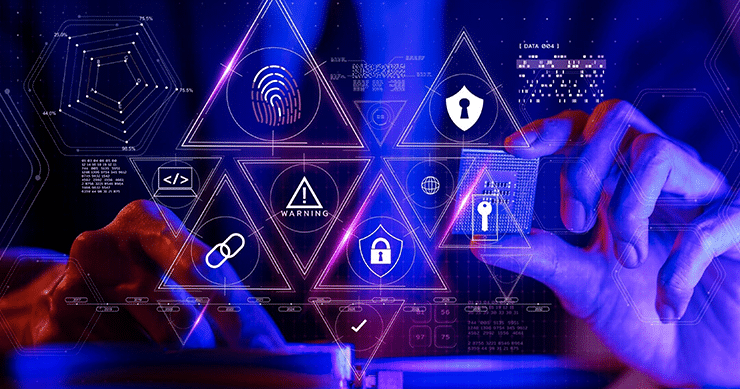Quantitative risk analysis refers to a numeric projection of the total impact of a given risk on business objectives.
A risk quantification model is a tool or approach that helps organizations understand and measure the potential risks and impacts associated with cybersecurity threats. It aims to provide a way to assess and quantify the likelihood of a cyber-attack or incident occurring and the potential consequences it may have on the organization.
Cyber risk modeling can help organizations prioritize their cybersecurity efforts. For example, if the model identifies a high-risk area that could be easily exploited by hackers, the organization can allocate resources to address that specific vulnerability.
The model also helps organizations make informed decisions about their cybersecurity investments. By quantifying the potential impacts of different cyber risks, organizations can better understand the potential financial and reputational consequences of a security breach.
The information provided by the model support decisions on how much to invest in preventive measures, incident response capabilities, or cyber insurance.

How Do You Select a Cyber Risk Quantification Tool?
Choosing a cyber risk model to quantify risk involves considering several factors and understanding the specific needs and context of your organization. Here are some steps to guide you in the process:
Define your requirements
Determine why you need a cyber risk quantification model and what specific objectives you want to achieve. For example, you might want to prioritize risk mitigation efforts, allocate cybersecurity resources effectively, or communicate risk to stakeholders.
Understand your organization
Consider the nature of your organization, its industry, size, and risk appetite. Different models may be more suitable for specific contexts. Factors like regulatory requirements, available resources, and the complexity of your technology environment should also be considered.
Evaluate model types
There are different types of cyber risk quantification models, each with its strengths and limitations. The three main risk models are:
- Qualitative models: These models use descriptive scales or subjective assessments to evaluate risks. They are often simpler and more cost-effective but may lack precision and objectivity.
- Quantitative models: These models use mathematical formulas, statistical analysis, and data inputs to estimate risk in numerical terms. They can provide more precise and objective results but require data availability and may be more complex to implement.
- Hybrid models: These models combine qualitative and quantitative approaches to provide a more comprehensive risk assessment.
Assess model capabilities
Consider the capabilities of each model you are evaluating. Look for features such as the ability to capture multiple types of risks, scalability, flexibility, and integration with existing risk management frameworks or tools. Evaluate the model’s ability to handle various cyber threats, vulnerabilities, and potential impacts on your organization.
Determine data requirements
Determine the data requirements for each model. Quantitative models typically require historical data, such as incident records, vulnerability data, or threat intelligence feeds. Assess whether your organization has the necessary data available or if you need to invest in data collection and analysis capabilities.
Start Getting Value With
Centraleyes for Free
See for yourself how the Centraleyes platform exceeds anything an old GRC
system does and eliminates the need for manual processes and spreadsheets
to give you immediate value and run a full risk assessment in less than 30 days
What is the FAIR Risk Quantification Model?
The FAIR (Factor Analysis of Information Risk) model is a widely recognized cyber risk quantification model. The FAIR model is specifically designed to provide a framework and methodology for quantifying and measuring information security and operational risk in financial terms.
The FAIR model takes a data-driven and analytical approach to cyber risk quantification. It uses a combination of factors, such as the frequency of events, the magnitude of potential loss, and the effectiveness of controls, to assess and quantify cyber risks in monetary terms. The model enables organizations to estimate the financial impact of potential security incidents and make more informed decisions about risk management and resource allocation.
The FAIR model provides a structured process for identifying and analyzing risk scenarios, collecting relevant data, and calculating the probable financial impact of cyber events. It helps organizations understand the probability of occurrence of different risks, the potential financial losses associated with those risks, and the effectiveness of different risk mitigation strategies.
By quantifying risks in financial terms, the FAIR model allows organizations to communicate cyber risk in a language that business executives and stakeholders can understand. It facilitates risk-based decision-making by providing a common basis for comparing and prioritizing risks, evaluating the cost-effectiveness of controls, and determining the appropriate level of investment in cybersecurity measures.
The FAIR model is widely recognized and utilized in the cybersecurity industry, and it is often used in conjunction with other risk management frameworks, such as NIST’s CSF or ISO 27001. It provides a comprehensive and systematic approach to cyber risk quantification, helping organizations enhance their risk management practices and improve the overall effectiveness of their cybersecurity programs. It’s important to note that the choice of a cyber risk quantification model depends on the specific needs and context of an organization. Each model has its own strengths, limitations, and areas of applicability. It’s advisable to evaluate multiple models and select the one that aligns best with your organization’s objectives, available resources, and risk management requirements.
Quantify Risk with Centraleyes
Centraleyes’ compliance and risk management platform streamlines the process of quantifying your cyber risk exposure. Our powerful platform calculates risk levels using an additive type of formula that outputs an overall risk score based on the NIST CSF. Cyber risk management and mitigation recommendations are then matched to the company’s chosen framework to support its overall risk management strategy.
Here’s an overview of how Centraleyes quantifies risk.
Data Collection
Centraleyes collects comprehensive data from various sources within the organization, including asset inventories, vulnerability scans, configuration data, threat intelligence feeds, and compliance information. This data serves as the foundation for risk quantification.
Asset Valuation
Centraleyes assigns a value to each asset based on its criticality to the organization’s operations. This valuation considers factors such as the asset’s importance, the sensitivity of the data it handles, and its role in supporting business processes.
Risk Analysis
Centraleyes analyzes the contextual information to assess the likelihood and potential impact of various risks.
Vulnerability Assessment
Centraleyes conducts vulnerability assessments to identify potential weaknesses or gaps in the organization’s systems, applications, and infrastructure. It analyzes the severity and exploitability of vulnerabilities discovered and integrates this information into the risk quantification process.
Control Assessment
Centraleyes evaluates the effectiveness of existing security controls and safeguards implemented within the organization. This includes assessing the maturity, coverage, and alignment of controls with industry best practices, regulatory requirements, and specific organizational needs.
Risk Quantification
Based on the collected data and analysis, Centraleyes applies its risk quantification methodology to quantify the level of risk associated with each asset. Risk scores are determined by considering the asset value, threat likelihood, vulnerability severity, and control effectiveness. The result is a quantitative measure of the inherent risk associated with each asset.
Prioritization
Centraleyes provides a risk prioritization framework that helps organizations focus on addressing the most critical risks first. It generates reports and visualizations that highlight high-risk areas, provides actionable insights, and support decision-making for risk mitigation efforts.
Reporting and Visualizations
Centraleyes provides visualizations, charts, and graphs that offer a clear and intuitive representation of risk assessment results. These visualizations can include risk heat maps, trend analysis, risk distribution charts, and other informative visuals to help stakeholders understand the risk landscape. Features include the ability to select the data to be included, choose the format and layout, add executive summaries, and tailor the level of detail to different audiences.
Centraleyes’ risk quantification approach allows organizations to understand their cyber risk landscape in quantitative terms. It helps prioritize risk mitigation efforts, allocate resources effectively, and make data-driven decisions to enhance their overall cybersecurity posture.
Start Getting Value With
Centraleyes for Free
See for yourself how the Centraleyes platform exceeds anything an old GRC
system does and eliminates the need for manual processes and spreadsheets
to give you immediate value and run a full risk assessment in less than 30 days






